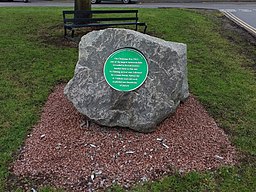Geologist and science writer Nina Morgan recalls how one Christmas kicked off with a bang
Morgan, N. Distant Thunder: A Christmas cracker.
Geoscientist 28 (11), 26, 2018
https://doi.org/10.1144/geosci2018-032; Download the pdf here

On Christmas eve 1965, people living near the Leicestershire village of Barwell were blinded by a flash, then deafened by a roaring noise and a tremendous bang that shook buildings. The flash was not the result of a Star from the East and the bang had nothing to do with Father Christmas crash landing his reindeer sleigh. Instead, the cause of all the commotion was a meteor strike. The 4.5-billion-year-old chondrite, or stony meteorite that hit the Earth near Barwell is the largest and best-recorded meteor fall in British history.
Mystery object
At first locals had little idea what had hit them. One woman reported hearing a tremendous crash when taking her dog for a walk in a nearby cow field, but she didn't recognise the significance of the noise. A member of a group of carol singers who set out across the village soon after the strike reported feeling something crunching under her feet. She picked up a piece of the meteorite, examined it under a street light, then threw it away. As she later explained, "I was out carol singing, I didn't want to carry a lump of rock around".
Other residents didn't realise what had happened until Christmas Day when they woke to find holes in the tarmac, broken windows and cracked roof slates. One resident whose new car was damaged by a meteorite fragment landing on its bonnet, initially threw the rock away, thinking it was a lump of concrete thrown by vandals. Once the true cause of the damage was recognised, insult was added to injury when his car insurance claim was refused on the basis that meteor strike damage was considered ‘an act of God’, and thus not covered. On receiving this response, the aggrieved car owner reportedly went to his local priest to see if the church would pay for the repairs. When church declined, the incensed motorist fired off a letter of complaint to his insurers that began 'Dear God'.
Meteorite hunters
But local attitudes towards the meteorite changed quickly, once the Christmas Eve event was confirmed as a meteorite strike and museums offered money for fragments of the space rock. The result was the meteoric equivalent of a gold rush.
Among those who joined in the hunt were the astronomer Patrick Moore and the geologist Trevor Ford, who found a fragment weighing in at 5 kg (see Distant Thunder,
Geoscientist March 2018). Some residents kept their meteorite fragments to display as a memento. But others cashed in. One local man, sold a large piece to the Leicester Museum for £39.50 and took his family on holiday on the proceeds. Another collector was even luckier: the 1 kg lump he picked up has a current estimated value of £20,000. In all, 44 kg of meteorite fragments were recovered.
But financial windfalls aside, the real winner in this saga is science. Meteorite fragments have the potential to provide important clues for understanding the origin and age of the Solar System. The Barwell meteorite is of particular interest because it is believed to be largely unmodified since its creation. And because pieces of meteorite were collected so soon after the impact, and many finders followed instructions to wrap samples in newspaper and avoid washing them, the samples were not degraded by weathering or contamination. To top it off, a pebble from another asteroid was found incorporated in one of the fragments, offering further clues about the meteorite's history and the formation of the early Solar System.
When it comes to Christmas presents, a fragment from the Barwell meteor must certainly beat a box of chocolates any day. A very happy holiday season to all!
End notes: Sources for this vignette include:
Incoming! Or why we should stop worrying and learn to love the meteorite by Ted Nield, 2011; A blog by Kevin Yates available at
https://spacecentre.co.uk/blog-post/day-meteorite-landed-barwell/; BBC news reports available at
http://www.bbc.co.uk/insideout/eastmidlands/series7/barwell_meteorite.shtml and The hunt for the Christmas meteorite by Camila Ruz in BBC News Magazine available at
https://www.bbc.co.uk/news/magazine-35053786
Nina Morgan is a geologist and science writer based near Oxford. Her latest book,
The Geology of Oxford Gravestones, is available via
www.gravestonegeology.uk Image Credit: Llama Bear (Wikimedia Creative Commons Attribution-Share Alike 4.0 International)